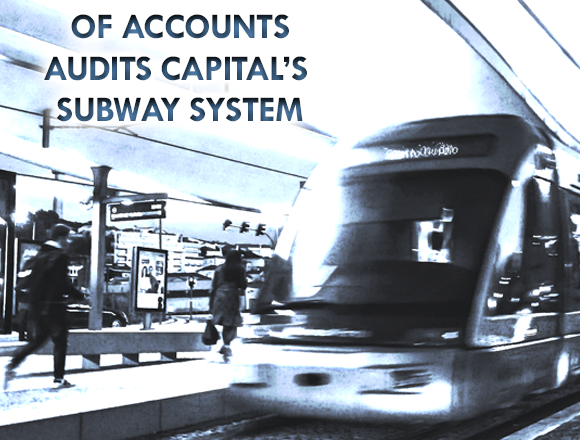Romanian Court of Accounts Audits Capital’s Subway System

by the Romanian Court of Accounts
The need to optimize, modernize and extend the current metro network is rigorous and is generated by a number of factors including:
- Estimated population growth dynamics of Bucharest (in 2020, there will be 2.36 million inhabitants and in 2030, about 2.55 million residents).
- Impact and positive benefits on the capital’s general transport and living conditions by (1) avoiding overcrowded surface traffic and (2) reducing the number of accidents, amount of travel time, pollution, energy consumption, road degradation and associated costs of transportation maintenance and repairs.
- Perspectives on building the future “Bucharest metropolitan area” in the absence of which the sustainable development the capital and nearby towns cannot be approached, planned and achieved.
Developing the Subway Transport System—Chronology and Evolution
Currently, there are two primary organizations that provide modes of public transportation for Bucharest:
- The Underground Transport Commercial Company Bucharest METROREX, S.A. (referred to as METROREX), which operates under the authority of the Ministry of Transportation. The company has duties, powers and responsibilities associated with managing and operating the subway transport system.
- The Autonomous Transportation Company of Bucharest (RATB): a self-managed public company subordinate to the General Council of the Bucharest Municipality. RATB has duties, powers and responsibilities in the management and operation of surface transport (trams, buses and trolleys).

Prior to 1970, to meet the demand for public transport in Bucharest, tracks were provided for the major surface routes in accordance with the city’s architecture (generally characterized by having relatively narrow streets and urban agglomeration areas whose systematization is confronted with significant obstacles). The solutions applied to surface transportation proved insufficient and unattractive and did not provide adequate conditions for passenger comfort. Thus, in the 70s, the decision was made to introduce a new mode of transport—the underground electric railway—a solution designed to ease surface transport congestion, while providing significant time savings for users due to higher commercial speeds. The electric railway would also drastically reduce pollution and enhance convenience and safety. As the 1980s neared, the Bucharest underground network had been built, equipped and was operational.

To better understand the dimensional coordinates of the METROREX activity, refer to the map of the Bucharest City metro network (Figure 1) and the chart highlighting the number of passengers (travelers) during the years 2010–2014 (Chart 1).
The Audit Approach
The audit mission’s overall objective was to evaluate government transport programs and activity performance with respect to implementation and operational efficiency and effectiveness. The audit also intended to assess if performance indicators were established in accordance with requirements as prescribed in “The Overall Strategy for Development and Modernization of the Metro Transport in Bucharest 2008-2030.”
The audit mission focused on risk identification, as well as vulnerability management (with the potential to generate failures and deficiencies found in previous audit actions carried out by the Court of Accounts).
Specifically, the proposed objectives were:
- Identify vulnerabilities, specific risks, failures and shortcomings (and consequences and associated responsibilities) associated with METROREX, S.A.
- Evaluate the consequences and responsibilities related to actions (and non-actions) of the State entities with duties, powers and responsibilities in the field.
- Identify potential areas and issues for improvement and make recommendations for enhancing performance in areas noted in the first two objectives.
The audit METROREX was conducted in terms of passenger satisfaction involving: (a) delivered services (by increasing quality and diversification), and (b) level of passenger security and safety (expanding to attract more travelers to use underground transport).
Audit Findings and Conclusions
The audit found two key conclusions:
- The Bucharest City metro has recorded an upward trend in work quality and trust of the traveling public despite the difficulties of (1) infrastructure maintenance, updates and expansion (in technical and technological terms) and (2) insufficient government-approved financial and staff resources.
- The grant from the state budget for operating activities was inadequate and not predictive in nature. The allocations for investment projects were constantly at a precarious level.
There were also a number of relevant findings connected to the entity’s activities: (1) the development strategy of the underground transport in Bucharest, (2) financing of the activity, (3) citizen reaction to travel tariff increases, (4) slow progress in expanding the metro network, (5) operation and administration of premises, (6) passenger satisfaction for services offered and (7) issues related to emergency situations.
Audit Recommendations
The recommendations cover several steps and measures, such as taking steps to include METROREX’s own strategy as part of a national program/strategy/transport master plan approved by the government or parliament would provide the “legal force” necessary to ensure funding predictability; identifying solutions to achieve proposed objectives; analyzing and adopting appropriate management by METROREX decision-makers and staff; performing comparative (benchmarking) and SWOT analyses to determine whether the activities are conducted in accordance with reported and recognized best practices; and improving the legislative framework.
Audit Impact
The audit mission, “Performance Audit Covering the Underground Transport of Persons in Bucharest,” provides a tremendous public impact. Objective and reliable information on these issues helps to increase transparency and accountability of all key players.
Parliament and Government—well-informed institutions. The legislative branch needs reliable and independent information on government actions and on the effects of its own decisions and laws. The performance audit, an independent assessment of the Bucharest public subway service’s performance, provides evidence and secures guidance on critical points that need to be reformed. Identifying potential improvements assists with reformation and public administration efficiency, as well as reduces government spending, all of which add substantially more value than that of a single control mechanism. Providing proper information will facilitate the implementation of recommendations on improving the legislative framework to support the work of the underground metro transport and will help the metro network optimize, modernize and expand.
Increase management performance at METROREX. The audit mission offers data concerning the degree of achieving program and activity objectives financed via public funding. Through its recommendations, the audit covers a wide spectrum of issues and provides, where possible, generic solutions with respect to: developing a formal and effective framework (organizational); performing measurements and evaluations; stimulating an objective; and performing unbiased internal reviews of processes, practices and systems. By referring to the best practices, the audit recommendations also show an clear methodological role.
Public interest and media communication. The general public are also taxpayers, making them primary stakeholders in knowing how public funds have been spent. Relevant social, political and economic matters also have an impact on the sustainable improvement of the general conditions of transport and life of the Romanian capital population.
In this framework, good communication with the media helps bridge the gap with citizens and other stakeholders and helps to build an accurate image concerning public services. Media opinions can generate significant impact on different issues included in the audit report.
Monitoring the implementation of recommendations, as well as the suggested improvements to the legislative framework on the underground transport (metro) activity provided by the Court of Accounts as a result of this audit will significantly help to optimize, modernize and expand the metro network, thus leading transport and quality of life sustainable improvements for residents of the Romanian capital.
To read the full report and request more information, contact the Romanian Court of Accounts at international.romania@rcc.ro or online at www.curteadeconturi.ro.





